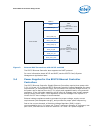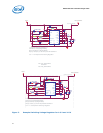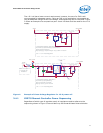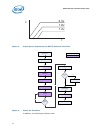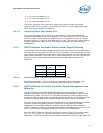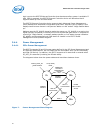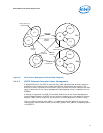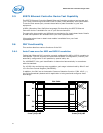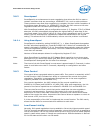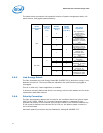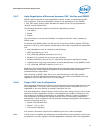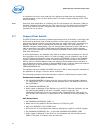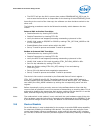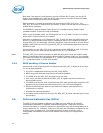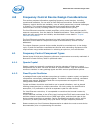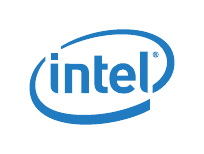
23
82575 Ethernet Controller Design Guide
3.6.2 Smartspeed
SmartSpeed is an enhancement to auto-negotiation that allows the PHY to react to
network conditions that are preventing a 1000BASE-T link, such as cable problems.
These problems may allow auto-negotiation to complete, but then inhibit completion of
the training phase. Normally, if a 1000BASE-T link fails, the PHY returns to the auto-
negotiation state with the same speed settings indefinitely.
With SmartSpeed enabled, after a configurable number (1-5, Register 27.8:6) of failed
attempts, the PHY automatically downgrades the highest ability it advertises to the
next lower speed: from 1000 to 100 to 10. Once a link is established, and if it is later
broken, the PHY automatically upgrades the capabilities advertised to the original
setting. This allows the PHY to automatically recover once the problem is corrected.
3.6.2.1 Using SmartSpeed
SmartSpeed is enabled by setting PHYREG.16.7 = 1. When SmartSpeed downgrades
the PHY advertised capabilities, it sets Bit PHYREG.19.5. When link is established, its
speed is indicated in PHYREG.17.15:14. SmartSpeed automatically resets the highest-
level auto-negotiation abilities advertised, if the link is established and then lost for
more than two seconds.
Number of failed attempts allowed is configured by Register 27.8:6.
Note: When SmartSpeed is enabled, the M/S (Master-Slave) resolution is not given seven
attempts to try to resolve M/S status (see IEEE 802.3 clause 40.5.2), this is because
SmartSpeed will downgrade the link after five attempts.
Note: The time to link with Smart Speed in most cases is approximately 2.5 seconds, in other
cases it could take more than 2.5 seconds, depending on configuration and other
factors.
3.6.3 Flow Control
Flow control allows congested nodes to pause traffic. Flow control is essentially a MAC-
to-MAC function. MACs indicate their ability to implement flow control during auto-
negotiation. This ability is communicated through two bits in the auto-negotiation
registers (PHYREG.4.10 and PHYREG.4.11).
Prior to auto-negotiation, the MAC indicates its flow control capabilities via
PHYREG.4.10 (Pause) and PHYREG.4.10 (ASM_DIR). After auto-negotiation, the link
partner's flow control capabilities are indicated in PHYREG.5.10 and PHYREG.5.11.
There are two forms of flow control that can be established via auto-negotiation:
symmetric and asymmetric. Symmetric flow control is for point-to-point links;
asymmetric for hub-to-end-node connections. Symmetric flow control allows either
node to flow-control the other. Asymmetric flow-control allows a repeater or switch to
flow-control a DTE, but not vice versa.
It is the responsibility of the MAC to implement the correct function. The PHY merely
allows the two MACs to communicate their abilities to each other.
3.6.4 Low-Power Link Up
Normally, PHY speed negotiation tries to establish a link at the highest possible speed.
The PHY supports an additional mode of operation, where the PHY drives to establish a
link at a low speed. The link-up process allows a link to come up at the lowest possible
speed in cases where power is valued over performance. Different behavior is defined
for the D0 state and the other non-D0 states.



